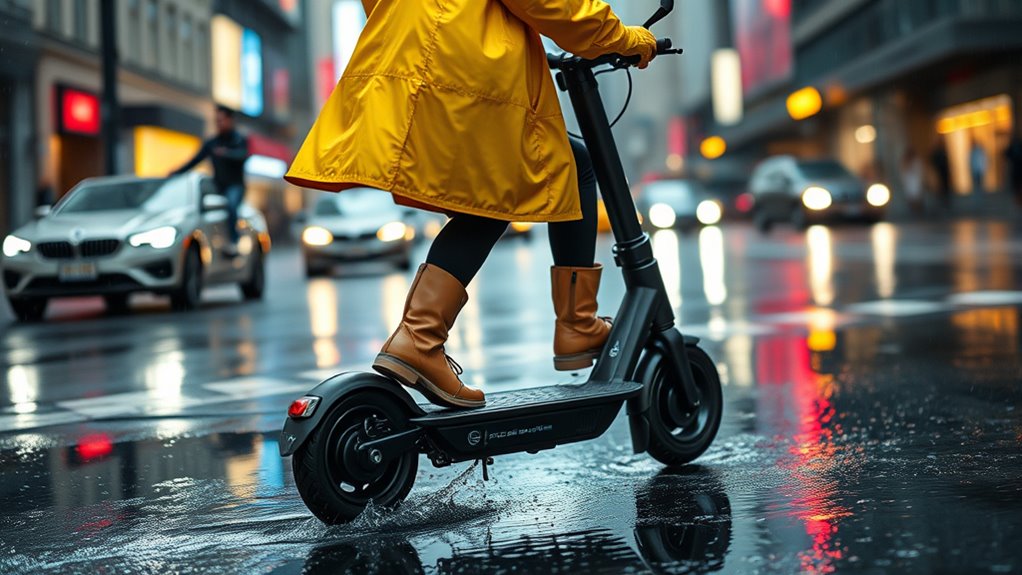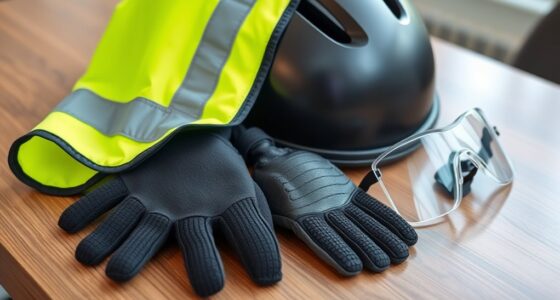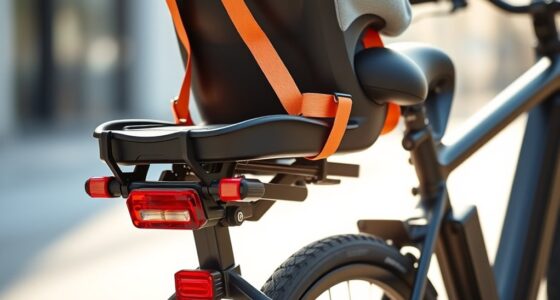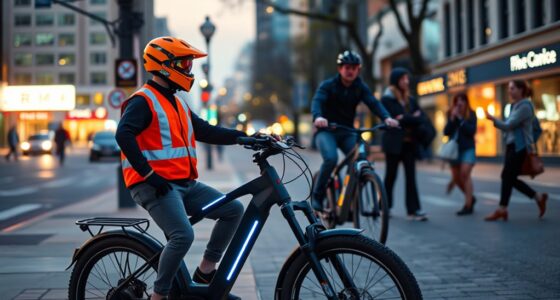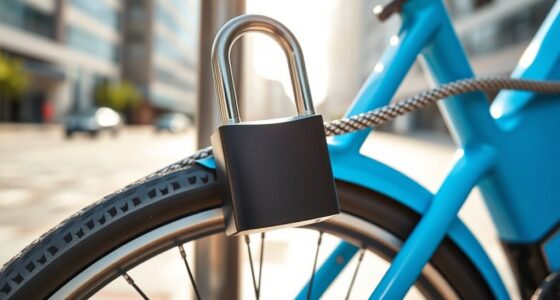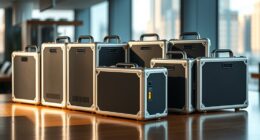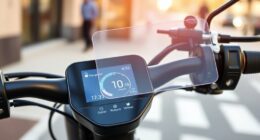To ride your e-scooter safely in wet weather, start by checking weather and road conditions beforehand. Wear waterproof gear and reflective accessories to stay visible and dry. Ride slowly on slippery surfaces, avoid puddles and potholes, and keep a firm grip on the handlebars. Use gentle braking, especially at intersections, and plan your route to steer clear of hazards. Stay cautious and alert—staying safe takes extra effort, and you’ll learn more to boost your safety.
Key Takeaways
- Check weather conditions and plan routes to avoid puddles, potholes, and flooded areas.
- Wear waterproof gear, including helmet visors, gloves, and reflective clothing for visibility.
- Reduce speed, handle brakes gently, and maintain a firm grip on the handlebars on wet surfaces.
- Stay alert at intersections, obey traffic signals, and watch for pedestrians and hidden hazards.
- Regularly inspect and maintain your scooter’s brakes, tires, and electrical components for safe operation.
Check the Weather and Road Conditions Before You Ride
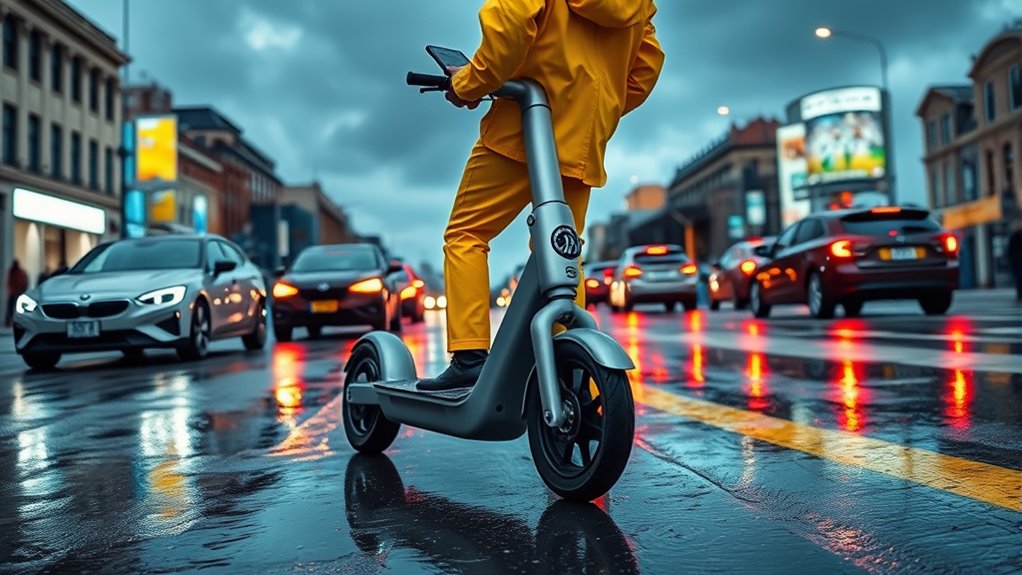
Before hopping on an e-scooter in wet weather, it’s essential to check the current weather and road conditions. Use reliable weather apps to get real-time updates on rain, temperature, and possible storms. These apps help you decide whether it’s safe to ride or if you should wait for the weather to improve. Also, consider checking the roads for puddles, slick spots, or flooding that could be hazardous. Wearing appropriate rain gear, like waterproof jackets and shoes, can make your ride more comfortable and safer if you decide to go ahead. Being aware of the weather conditions beforehand allows you to plan your route better and prepare for any unexpected changes, reducing the risk of accidents or discomfort during your ride. Recognizing narcissistic traits in your surroundings can help you stay alert to manipulative behaviors that might compromise your safety.
Wear Appropriate Safety Gear for Wet Weather
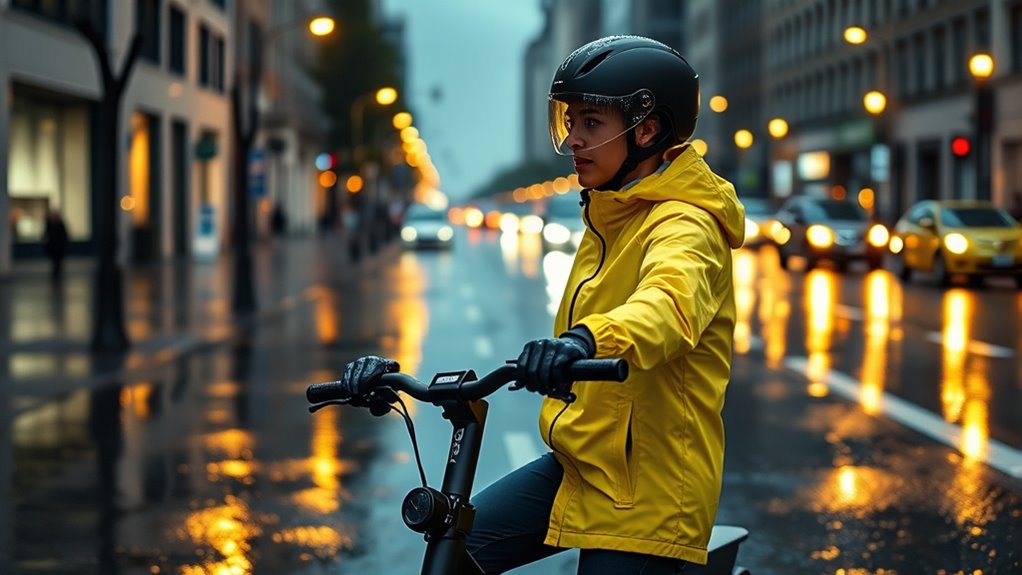
Wearing the right safety gear can considerably improve your protection and comfort when riding an e-scooter in wet weather. Make sure you choose appropriate gear designed for wet conditions, such as waterproof clothing that keeps you dry and warm. A waterproof jacket and pants help prevent chills and reduce the risk of slipping caused by wet fabric. Wear a helmet with a visor or a clear, waterproof face shield to keep rain out of your eyes and maintain visibility. Reflective accessories or clothing are also essential to increase your visibility to others. Additionally, consider waterproof gloves to maintain a firm grip on the handlebars and keep your hands dry. Proper gear not only boosts safety but also makes your ride more comfortable in challenging weather. Incorporating AI-powered safety features into your gear can further enhance your protection during wet conditions.
Adjust Your Riding Style for Slippery Surfaces
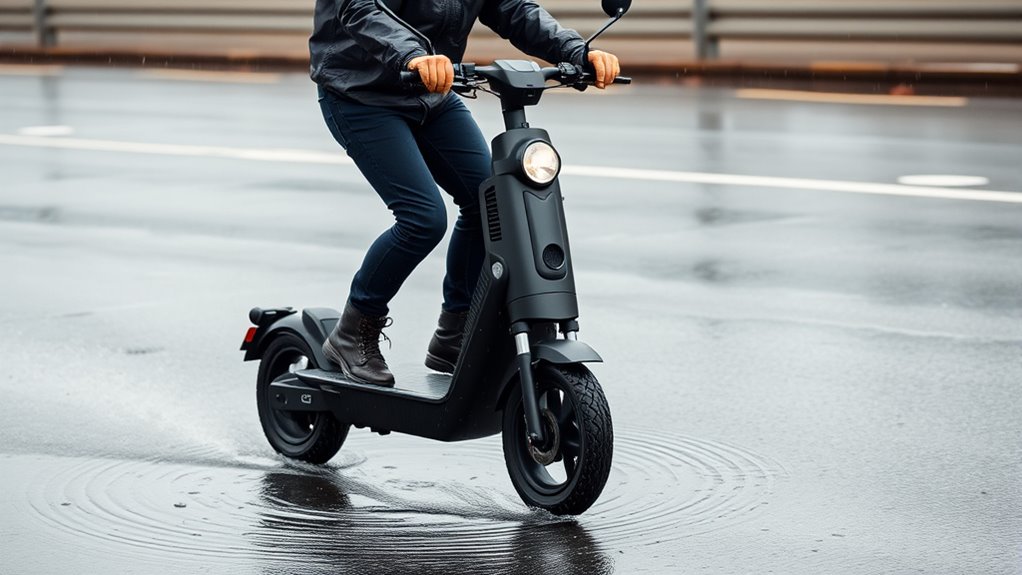
When riding an e-scooter on wet, slippery surfaces, it’s essential to adjust your riding style to maintain control and prevent accidents. Focus on smooth, gradual movements to enhance traction control and avoid sudden turns or accelerations. Keep your tire pressure at recommended levels; properly inflated tires improve grip and stability on slick surfaces. Reduce your speed considerably, especially around curves, to give yourself more time to react if traction decreases unexpectedly. Stay alert to changes in surface conditions, and avoid puddles or debris that could cause slipping. Additionally, selecting suitable tires designed for wet conditions can significantly improve your safety. By riding cautiously and adjusting your style, you’ll improve your safety and reduce the risk of falls. Remember, controlling your speed and maintaining proper tire pressure are key to staying steady on wet, slippery roads.
Maintain and Inspect Your E-Scooter Regularly

To stay safe in wet weather, you need to keep your e-scooter in top shape. Regularly check that the brakes work properly, and inspect the tire tread for adequate grip. also, examine electrical components to prevent malfunctions that could make riding risky. Additionally, ensuring suspension upgrades are well-maintained can improve handling on slippery surfaces.
Check Brake Functionality
Regularly checking and maintaining your e-scooter’s brakes is essential for safe riding, especially in wet weather. You should test brake responsiveness by applying the brakes gently to ensure they engage smoothly and promptly. If you notice any delay or stiffness, it’s time to service them. Pay attention to brake noise; squeaking or grinding sounds often indicate worn pads or inadequate lubrication. Address any abnormal noise immediately, as it can compromise braking efficiency. Inspect the brake levers and cables for signs of wear or damage, ensuring they operate smoothly. Consistent maintenance helps prevent failure during rainy rides and ensures you can stop quickly when needed. Staying proactive with brake checks keeps you safer and more confident, no matter the weather conditions. Additionally, checking brake performance regularly can help identify issues early and prevent potential accidents.
Inspect Tire Tread
Inspecting your e-scooter’s tire tread is vital for safe riding, especially in wet weather. Adequate tread depth ensures your tires grip the road and shed water effectively, reducing the risk of slipping. Check for signs of uneven wear or bald spots, which can compromise traction. Also, maintain proper tire pressure, as underinflated tires can reduce contact with the ground, decreasing stability. Regularly inspecting tread depth and tire pressure helps you identify problems early, preventing accidents. If the tread looks worn or the tire pressure is too low, replace or inflate your tires before riding. Keeping your tires in good condition is a simple but essential step to guarantee safety, especially when riding through wet or slippery conditions. Proper tire maintenance not only improves safety but also extends the lifespan of your e-scooter tires.
Examine Electrical Components
Have you checked your e-scooter’s electrical components lately? Making sure they’re in good shape is essential, especially in wet weather. Start by inspecting waterproof seals around connectors and wiring. These seals prevent water from seeping into sensitive parts, reducing the risk of shorts or corrosion. Next, examine the electrical insulation on wires and connections; look for cracks or damage that could expose wiring to moisture. Proper electrical insulation keeps the system safe and functional. Regularly cleaning dirt and debris from electrical areas also helps maintain the integrity of these components. If you notice any compromised waterproof seals or damaged insulation, replace them immediately. Staying vigilant with these checks can prevent malfunctions and ensure your e-scooter remains safe and reliable during wet rides. Additionally, understanding payment processing can help you be aware of how electronic systems are protected from cyber threats, ensuring your device’s data stays secure.
Use Proper Braking Techniques on Wet Roads

When braking on wet roads, it’s essential to adjust your technique to prevent slipping or skidding. Wet surfaces increase your braking distance, so start slowing down earlier than usual to give yourself enough time to stop safely. Use both brakes gradually instead of sudden, hard presses, which can cause your wheels to lock up. This controlled approach helps maintain traction and reduces the risk of losing control. In case of an emergency stop, apply firm, steady pressure to both brakes without releasing, ensuring the scooter slows evenly. Remember, aggressive braking can lead to skidding on wet pavement. Staying alert and adjusting your braking habits keeps you safer and helps you respond quickly if unexpected hazards appear. Additionally, understanding braking techniques and the importance of proper maintenance can further enhance your safety on wet roads.
Be Extra Cautious at Intersections and Crosswalks
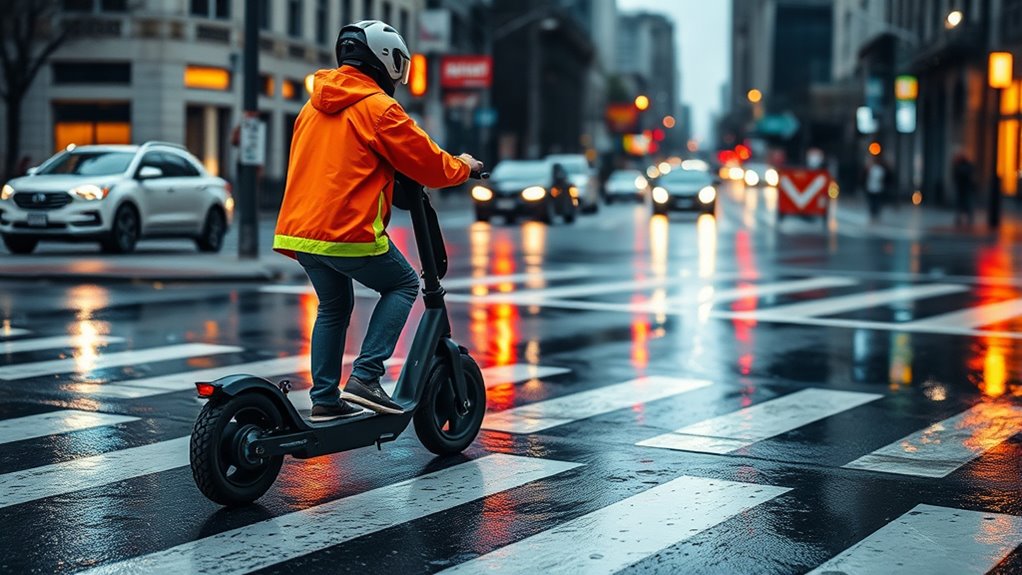
Braking carefully on wet roads is essential, but it’s equally important to stay vigilant at intersections and crosswalks. Wet conditions can reduce your control and increase stopping distances, so slow down as you approach these areas. Pedestrian awareness is vital; watch for pedestrians who might not be fully visible or suddenly step onto the crosswalk. Always obey traffic signals and crosswalk signs, even if the light is changing. Signal compliance helps both you and pedestrians stay safe by clearly indicating your intentions. Be prepared for unexpected movements, as slippery surfaces can cause skidding or loss of balance. Using proper hot rollers can help you achieve a quick and secure hairstyle, reducing the time spent handling styling tools in unpredictable weather. By staying alert and respecting pedestrian zones, you minimize risk and navigate intersections more safely in wet weather.
Plan Your Route to Avoid Puddles and Potholes
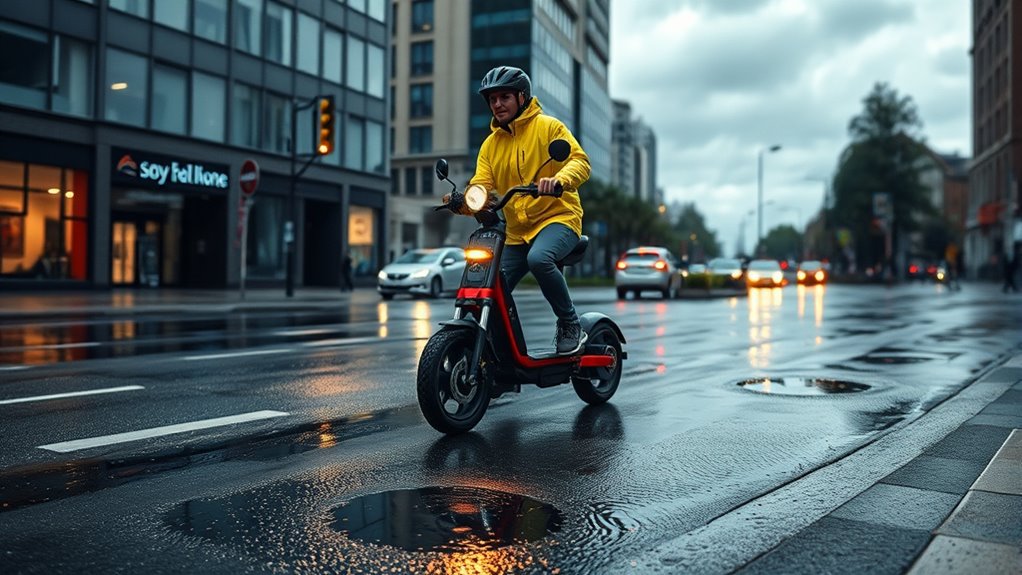
Since wet weather can make puddles and potholes more difficult to spot, planning your route carefully helps you avoid potential hazards. Take a moment to assess the area before you start riding. Use your phone or a map to identify streets with well-maintained pavement and fewer puddles. Stick to routes that are less likely to have standing water or hidden potholes, especially on smaller or poorly lit roads. Look for bike lanes or designated paths, as they’re usually better maintained. Practice hazard avoidance by staying alert to potential trouble spots and adjusting your route if necessary. Proper route planning not only reduces the risk of accidents but also makes your ride safer and more comfortable in wet conditions. Additionally, choosing routes with better safety features can help minimize risks associated with electric scooters in adverse weather.
Frequently Asked Questions
How Do I Handle Sudden Puddles or Standing Water While Riding?
When you encounter sudden puddles or standing water, focus on puddle navigation by slowing down and steering smoothly to avoid splashes. Keep your weight centered and maintain a steady speed to prevent water splash prevention issues. If the water seems deep, it’s best to dismount and find an alternative route. Staying alert helps you respond quickly, ensuring safer riding and minimizing the risk of slipping or losing control.
Are There Specific E-Scooter Models Better Suited for Wet Weather?
When choosing an e-scooter for wet weather, look for models with weatherproof features like sealed electrical components and water-resistant tires. These scooters require regular maintenance to guarantee weatherproof seals stay effective. You’ll find that some brands prioritize e-scooter maintenance and design for wet conditions, making them safer and more reliable in rain. Picking the right model helps you ride confidently, even when the weather isn’t ideal.
What Should I Do if My Brakes Fail in Wet Conditions?
If your brakes fail in wet conditions, stay calm and act quickly. Remember, regular brake maintenance can prevent this. Use emergency procedures like gently pressing the brake lever and shifting your weight back to slow down. If stopping isn’t possible, look for a safe obstacle or area to reduce speed gradually. Always check your brakes before riding and practice emergency stops so you’re prepared if a failure occurs.
Can Wet Weather Damage My E-Scooter’s Electrical Components?
Wet weather can affect your e-scooter’s electrical components if you’re not careful. Water exposure may cause corrosion or short circuits, especially if you don’t maintain your battery properly. To protect your scooter, regularly check and clean the battery connections, and make certain they’re dry. Also, pay attention to tire traction; wet roads reduce grip, so ride slowly and cautiously to avoid slipping and potential damage.
How Can I Improve Visibility During Rainy or Foggy Conditions?
To improve visibility during rainy or foggy conditions, you should wear rain gear and reflective clothing. These help you stay dry and make you more noticeable to others. Use a bright or LED headlight on your e-scooter, and consider adding reflective strips or stickers. Keep your lenses clear, and stay alert. Proper visibility keeps you safe, especially when weather reduces how well others can see you.
Conclusion
Riding an e-scooter in wet weather demands caution, much like steering a busy street. While the rain can slow you down and make surfaces slick, it also offers a fresh perspective—seeing the world in a different light. Stay alert, wear your gear, and plan carefully. Embrace the challenge, then enjoy the ride, even in the rain. After all, safe riding turns a rainy day into an adventure rather than an obstacle.
